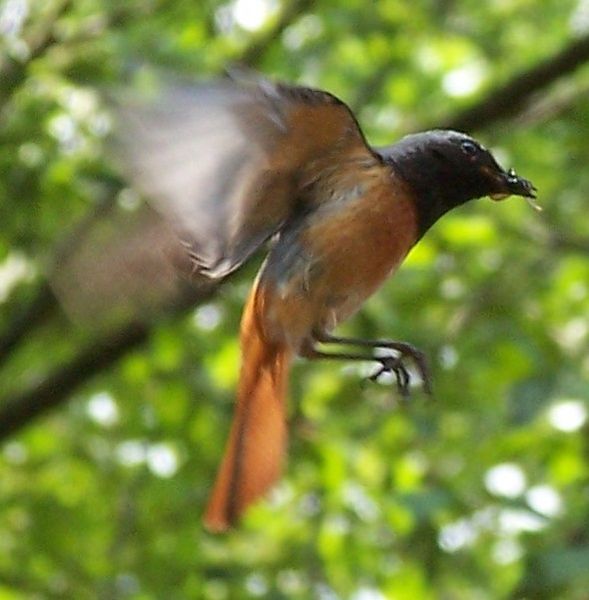.
By and by I had a better bird to listen to—a redstart. A female flew down within fifteen yards of me; her mate followed and perched on a dry twig, where he remained a long time for so shy and restless a creature. He was in perfect plumage, and sitting there, motionless in the strong sunlight, was wonderfully conspicuous, the gayest, most exotic-looking bird of his family in England. Quitting his perch, he flew up into a tree close by and began singing; and for half an hour thereafter I continued intently listening to his brief strain, repeated at short intervals—a song which I think has never been perfectly described. "Practice makes perfect" is an axiom that does not apply to the art of song in the bird world; since the redstart, a member of a highly melodious family, with a good voice to start with, has never attained to excellence in spite of much practising. The song is interesting both on account of its exceptional inferiority and of its character. A distinguished ornithologist has said that little birds have two ways of making themselves attractive—by melody and by bright plumage; and that most species excel in one or the other way; and that the acquisition of gay colours by a species of a sober-coloured melodious family will cause it to degenerate as a songster. He is speaking of the redstart. Unfortunately for the rule there are too many exceptions. Thus confining ourselves to a single family—that of the finches—in our own islands, the most modest coloured have the least melody, while those that have the gayest plumage are the best singers—the goldfinch, chaffinch, siskin, and linnet. Nevertheless it is impossible to listen for any length of time to the redstart, and to many redstarts, without feeling, almost with irritation, that its strain is only the prelude of a song—a promise never performed; that once upon a time in the remote past it was a sweet, copious, and varied singer, and that only a fragment of its melody now remains. The opening rapidly warbled notes are so charming that the attention is instantly attracted by them. They are composed of two sounds, both beautiful—the bright pure gushing robin-like note, and the more tender expressive swallow-like note. And that is all; the song scarcely begins before it ends, or collapses; for in most cases the pure sweet opening strain is followed by a curious little farrago of gurgling and squeaking sounds, and little fragments of varied notes, often so low as to be audible only at a few yards' distance. It is curious that these slight fragments of notes at the end vary in different individuals, in strength and character and in number, from a single faintest squeal to half a dozen or a dozen distinct sounds. In all cases they are emitted with apparent effort, as if the bird strained its pipe in the vain attempt to continue the song.
Phoenicurus phoenicurus (Redstart): engraving by Benjamin Fawcett, original plate hand-painted in colour: from A History of British Birds, Rev. F.O. Morris, 1880: photo by Tomcon3, 2007
The statement that the redstart is a mimic is to be met with in many books about birds. I rather think that in jerking out these various little broken notes which end its strain, whether he only squeaks or succeeds in producing a pure sound, he is striving to recover his own lost song rather than to imitate the songs of other birds.
W.H. Hudson, from An Old Road Leading Nowhere, in Afoot in England, 1901






6 comments:
For those who are interested, some more Hudsoniana may be found in the text and comment thread here.
Hi Tom,
I read a piece called "Humility" in my Google reader and came here to comment and it was gone.
Cheers,
Robb
Tom,
What great stuff from WH Hudson -- I remember (or do I?) reading Green Mansions at Burlingame HIgh School, that's it. Link to "Idle Days in Patagonia" doesn't seem to be linking (today), too bad. His listening to the birds here leaves tunes one's ears (anew) --- what is THAT one I'm hearing, and THAT one?
Steve,
You can find Idle Days in Patagonia here.
(I've just checked that link and the book is there.)
And Robb: Humility may be found...here.
(It's been a long night.)
thanks Tom, link HERE has taken me clear to Patagonia
Post a Comment